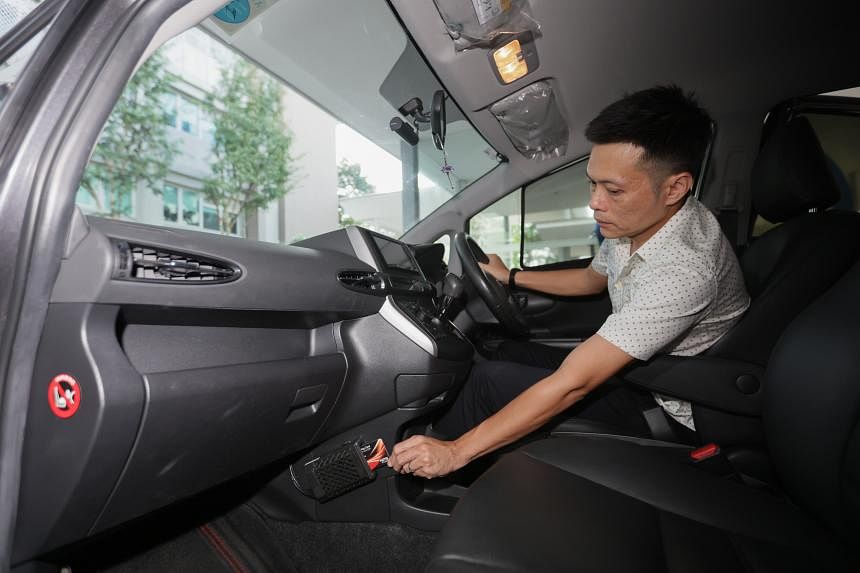SINGAPORE – Motorists who have had the next-generation Electronic Road Pricing system (ERP 2.0) on-board units (OBU) installed in their vehicles as at May 2 can reposition the processing units from the passenger’s footwell to the driver’s footwell for free if they wish, said Transport Minister Chee Hong Tat.
About 2 per cent, or 18,000 vehicles, of almost one million vehicles in Singapore have been fitted with OBUs since August 2023, noted Mr Chee, with around 11,000 of them being fleet vehicles such as buses and company-registered vehicles.
Mr Chee said this in Parliament on May 8 in response to questions from MPs on public concerns about the design of the ERP 2.0 on-board unit.
This follows complaints from drivers about potential safety risks in reaching for payment cards located at the passenger’s footwell, as well as the bulkiness of the three-piece OBU comprising the processing unit, an antenna and a touchscreen display.
Previously, early adopters of the ERP 2.0 had no choice but to place the processing units in the front passenger’s footwell when the OBUs were installed in their vehicles from August 2023.
To ensure fairness, the switch in the location of the ERP 2.0 processing units will be free for these users, said Mr Chee in response to a question from Dr Lim Wee Kiak (Sembawang GRC) who asked about Mr Chee’s experience with the unit as an early adopter.
Mr Chee’s response came six days after the Land Transport Authority confirmed that the processing unit of the new OBUs can be installed on the driver’s side, if suitable.
The installation of the new OBUs began in fleet vehicles in November 2023, and new vehicles registered from May 1 will be pre-fitted with the equipment.
Reiterating the complexity of the ERP 2.0 transition, Mr Chee said the adoption of new OBUs is a major exercise involving many motorists and a diverse range of vehicle makes and models, including new and existing vehicles.
The process will take a few years to complete, he added.
On Dr Lim’s query about whether the smaller one-piece OBUs for motorcycles can be used in cars, he said there is a risk of overheating in enclosed vehicular environments, which could affect their functionality.
He added that the units could be designed with cooling fans, but this was decided against as it would make the one-piece units very bulky on dashboards.
Mr Chee noted that the splitting of the OBU into three parts allows drivers the flexibility to decide on the location of the processing unit, and to do without the touchscreen display if they prefer.
As one of the early adopters, Mr Chee said he had some initial concerns about not being able to reach his payment card conveniently if he had to use complimentary parking tickets.
He said he was happy that LTA introduced a new feature in April allowing drivers to deactivate their payment cards whenever they use complimentary parking tickets at carpark gantries, without needing to remove their cards from the processing unit.
If a motorist forgets to reactivate the card after leaving the carpark, the correct amount will still be deducted from the card balance when he reaches the next active ERP gantry.
Adding that ERP 2.0 is designed to prevent motorists from needing to remove their payment cards from the processing unit while they are driving, Mr Chee noted that drivers can view the balance on their payment cards on the touchscreen display once they start their cars.
Motorists who have installed the OBUs can also opt for automatic top-ups for their payment cards, and use the free Motoring Card that will be provided by payment firm Nets at privately owned carparks without the Electronic Parking System, said Mr Chee.
Currently, all public carparks and many private carparks use the Electronic Parking System.
Workers’ Party (WP) MP Gerald Giam (Aljunied GRC) asked about the impact of distance-based charging on people who drive for a living, given the inevitability of its roll-out since it was one of the key reasons for the transition to ERP 2.0.
Responding, Mr Chee said Mr Giam should not “jump the gun”.
A new feature of the satellite-based ERP 2.0 is the ability to charge motorists based on the distance travelled, although the authorities have said there are no immediate plans to roll this out.
Mr Chee noted that the ministry is looking at distance-based charging as a “possible option” that it has to study further, something he mentioned during the debate on the Ministry of Transport’s budget on March 5.
He acknowledged there are trade-offs affecting different groups of stakeholders, thus the ministry needs to be “quite careful and deliberate” in its review.
“I did not suggest that (distance-based charging) is an inevitable outcome (of ERP 2.0),” said Mr Chee, “... What ERP 2.0 gives us is the option to do distance-based charging, if we wish to do so.”
Addressing Mr Giam’s question on the viability of a smartphone-based system as a default for ERP 2.0, Mr Chee reiterated that the system requires devices to be permanently affixed to the vehicle to track its location.
In addition, the OBUs have higher levels of data security with one-way data transmission, instead of smartphones’ two-way data transmission, he added.
While a smartphone-based system would be unable to fulfil all the functions of ERP 2.0, Mr Chee said a smartphone can be used to replace the touchscreen display, if used together with the processing unit and antenna.
To WP MP Louis Chua’s (Sengkang GRC) question on the OBU’s compliance with international safety standards, Mr Chee said a series of tests, including temperature, safety and crash tests, has been conducted on the OBUs to ensure there is no safety risk to motorists.
Correction note: This story has been edited for accuracy.

